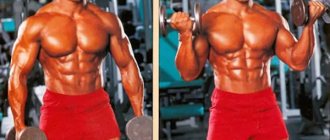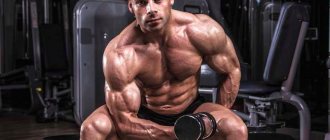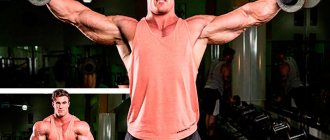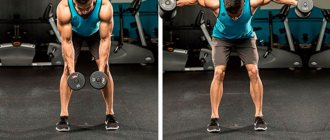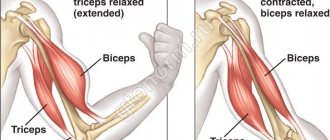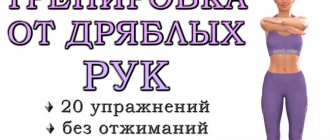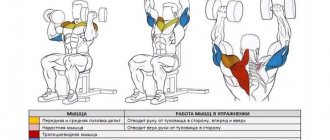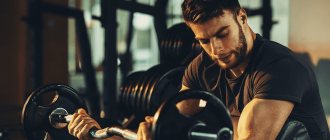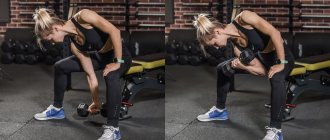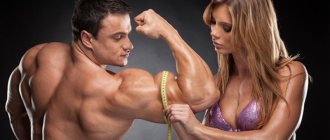August 27, 2015 Admin Home page » Biceps
The completely correct technique for performing dumbbell curls for biceps while sitting - standing, starting position, main mistakes, recommendations and advice from experts + training video is described.
An excellent basic exercise for increasing arm power, it should come second on the list for biceps, for example, after standing barbell curls.
Technique for lifting dumbbells while sitting - standing
Take a few deep breaths as you prepare to perform the exercise, then take a deep breath and exhale, lift the dumbbell from the bottom position to the top, while rotating your wrist so that about halfway through the movement it is half-unfolded, and at the top point your palm is fully facing you, this process is called supination (rotation of the hand).
At the top point, tighten your biceps as much as you can, you will immediately feel that it is burning, this is the peak of muscle fiber contraction. Lower the dumbbell down while inhaling and repeat on the next hand.
Working muscles
- The main muscle worked is the biceps brachii. This is the biceps, which is what we want to develop when we do a lot of lifts and strive to perform more repetitions with impressive weight;
- The brachialis and brachyradialis, the brachialis and brachioradialis muscles, help with movement. The first is responsible for the size of the forearms in the aesthetics of the body, the second – as if “raises” the biceps, if it is qualitatively hypertrophied;
- The front deltoids act as stabilizers. They help balance weight during movement and are statically tense. The triceps are partially activated as stabilizers if the dumbbells are lowered slowly enough
This exercise is effective for athletes of any level of training. It can be performed in two variations of palm placement:
Supination is the turning of the hand outward.
- With the palm facing the stomach;
- Supinated lift, that is, palms up
There are also several variations of the starting position:
- Simple standing rise;
- Movement with the forearm resting on the thigh while sitting (concentrated lifting);
- Lifting while sitting on a bench;
- Lifting while sitting on an inclined bench;
- Raising with dumbbells "hammer"
Tips for implementation
1) You can lift the dumbbells not together, but one at a time, this way you can take up to 10% more weight, just be careful that the body does not sway from side to side. The biceps should lift the dumbbell, not the back and body swaying.
2) When lifting the dumbbell up, leave a distance to the shoulder of about 15-20 cm, and move your elbow 10 cm forward, this will allow you to contract the biceps more strongly and feel the peak of muscle contraction.
3) From the bottom point, lift the dumbbell exclusively with the strength of your biceps, do not throw the dumbbell up, this will certainly make the exercise easier, but its effectiveness will greatly decrease.
4) If you have back problems, do dumbbell curls while sitting, this will reduce the load on the lower back, but the option of doing it in a standing position will help to include cheating in the last working repetitions.
5) To increase the load on the inner part of the biceps, take the dumbbell not in the middle, but move the grip as much as possible towards the thumb, so that on the outer part of the biceps, move the closed grip towards the little finger.
Exercise options
All variations involve the biceps and brachialis in one way or another. The question is “proportions”. The option with emphasis on the thigh isolates the biceps more, supination distributes the load equally, and the “hammer” and reverse grip focus attention on the brachialis.
Hip-centric – concentrated lift
There is an opinion that concentrated lifting needs to be done with heavy weight, but this is not true. It is enough to perform it cleanly and with less burden to get a significant effect. This movement is also suitable for pumping up the peaks of the biceps.
The technique is like this:
- Select a bench of adequate height so that your thighs are parallel to the floor;
- The exercise is performed first with the weaker hand;
- The elbow rests on the thigh of a leg standing stably on the floor, the toe is turned out as in a squat, the knee is bent;
- The body tilts slightly towards the working hand, but does not fit on the thigh;
- The hand with the dumbbell rises smoothly as you exhale;
- The projectile goes to the shoulder;
- The rules for turning are the same as in the classic lift, turn in the middle of the amplitude;
- In this technique there is a tendency to roll your back towards your working arm and hunch over. You need to control yourself and not allow changes in body position.
Lying on an incline bench
The incline biceps curl is an exercise from a stretched biceps position. It is performed both with supination and with a “hammer”, and is intended for concentrated work on the biceps.
The technique is like this:
- The bench is set at an angle of forty-five degrees or slightly lower. You need to choose a position in which there will be no pain in the shoulder joints;
- You need to press your back to the bench quite tightly, while pulling your shoulder blades towards your spine;
- The dumbbells are lifted to the middle of the amplitude with a “hammer”, then the arms are turned palms up;
- At the top point of the wrist, look towards the forearm, the biceps is contracted, but there is no need to specifically bring the arm to the shoulder;
- You need to stop at the point of amplitude where the muscle is contracted to its maximum;
- Lowering occurs as if in the reverse order, but slowly
Working on a bench with a straight back is used by those athletes who would like to get rid of cheating with their backs, and cannot perform the exercise pressed against the wall, since there is simply no such opportunity in the gym.
Leaning your back against a wall has one technical nuance - your back should be completely pressed, your forearms should be to your sides, but it makes sense to push your feet forward so that the body position is stable in the stance.
Standing Dumbbell Curl for Biceps! Kock technique!)
Tips for maximum efficiency
- For more comfortable lifting, use shoes with hard soles. If possible, perform the exercise barefoot.
- During movement, the knees should not be brought together.
- Work at the maximum possible amplitude. Even if you perform the exercise without a platform.
- Don't lean forward or round your back. This will not only put stress on the spine. But there will also be a temptation to perform the exercise by swinging the body.
- To get more out of your lifts, you should perform them in combination with other exercises to develop your lower leg muscles.
- If your calves are lagging muscles, then it’s worth setting aside another day for their development.
- You need to work until your calf muscles burn. Therefore, the optimal number of repetitions will be 12-15 per approach.
- In the lower position, there is no need to pause. We lowered our heels down and immediately pressed upward with force.
- Throughout the exercise, the hip joints should be motionless. We work only by contracting the triceps muscles of the leg.
- Use a weight that you can handle with proper form and full range of motion.
Calf raises are a technically simple exercise. But you need to take it seriously if you want to pump up big calves. Try to feel the target muscles working in each repetition. Work until it burns, and your calves will be forced to respond with growth to your efforts.
Good luck to everyone in your training!
What muscles does seated calf raise work?
When performing seated calf raises, most of the load falls on the muscles of the back of the lower leg. These include:
- Calf muscles. It consists of two heads. Medial internal and lateral external. Its functions include: participates in flexion of the leg at the knee joint, stabilizes the body and flexes the foot.
- Soleus.
Lies under the calf muscle. Below it connects with it into one powerful tendon. Its functions include: flexion of the foot and stabilization of the lower leg in a standing position.
Together they form the triceps surae muscle. There is one important factor to consider. The calf muscles cross the knee joint and attach to the tibia. Therefore, we can achieve greater inclusion of them with fully straightened legs. The soleus is attached to the tibia. To shift the emphasis to it, you need to bend your knees. That's what we do when we do seated calf raises.
Lifting dumbbells with emphasis on the thigh[edit | edit code]
Source:
“Bodybuilding.
Book trainer" .
Editor:
Oksana Usoltseva
Ed.
: Eksmo 2013
Lifting dumbbells with emphasis on the thigh
or Concentrated biceps curl/Concentrated biceps curl
Inventory
: bench, dumbbells.
Core muscles
: biceps.
Additional muscles
: forearms.
Level of training
: intermediate to professional.
This is perhaps the most effective exercise for getting your biceps into peak condition. It is very popular when preparing for competitions.
Step 1
. Sit on a bench and hold a dumbbell in one hand. The elbow rests on the inner thigh. Keep your forearm straight.
Step 2
. Raise the dumbbell to your shoulder, bending your elbow. Keep your wrist and back straight.
Step 3
. Slowly return to the starting position.
Muscles working when bending one arm with a dumbbell: 1 - biceps; 2 - shoulder; 3 - flexor carpi radialis; 4 - long palmar; 5 - flexor carpi ulnaris; 6 - brachioradial; 7 - extensor carpi radialis longus; 8 - short extensor carpi radialis
Benefits of seated calf raises
- Targeted load on the muscles of the back of the lower leg. In particular, on soleus. Their development will visually increase the calf muscles. Making them more voluminous.
- The axial load on the spine is reduced. What makes the exercise less traumatic.
- The calf muscles will become stronger. Which will have a positive effect on increasing weight in basic exercises for the leg muscles.
- You can perform the exercise not only in the simulator, but also with free weights. If your gym doesn’t have special equipment for developing calf muscles, it doesn’t matter. We take a barbell or dumbbells and do calf raises while sitting.
- The development of the lower leg muscles will help improve results in disciplines such as running and jumping. Therefore, track and field athletes pay a lot of attention to training their calf muscles.
Just one exercise provides so many benefits. All that remains now is to master its technique and choose the option that will be your assistant when training your calf muscles.
History and records
In modern commercial gyms you can meet many men who dream of acquiring 45-centimeter biceps. Many people do this. Some people spend years on this. Someone achieves their goal by using anabolic steroids.
Pay attention to home exercise machines for weight loss. Review and rating of the best simulators.
The news contains a description of lunges with dumbbells. Why do this exercise?
Review of prices for strength training equipment for home!
And someone builds arms with a girth of 50 centimeters or more, without resorting to “chemistry” and in a relatively short time. In all these cases, the basic exercise for developing biceps helps very well.
Classic barbell curls once helped Arnold Schwarzenegger. He could perform 6-8 perfect biceps curls with a 100kg barbell. Those who believe that the former governor of California owes this achievement to his large muscle mass are not entirely right.
In 2012, this record was broken by Valery Rashoyan, a little-known (until the new record was set) athlete from Kursk. Rashoyan’s weight is less than 80 kg, which is almost 30 kg lighter than the weight of Iron Arnie.
Basic mistakes
No warm-up
For the thousand and first time, let’s name the most common mistake beginners make when they do, among other things, lifting dumbbells while sitting - lack of warm-up. Before performing the exercise, you need to thoroughly warm up the joints and muscles of the shoulders.
If necessary, you need to lubricate the skin around them with a warming ointment (follow the instructions so as not to get a negative effect from the use of warming ointments, for example, severe burning during exercises). Then you need to perform a warm-up approach with light weight. Then start working.
If you don’t do this, you can get injured and forget about any chest and shoulder exercises for six months. Unless, you will not perform these elements with your healthy hand.
Performing a one-arm press
Seated dumbbell lifting is sometimes called a military press with dumbbells. This name reflects the whole essence - the word “dumbbells” is used in the plural. Just like in the name “seated dumbbell press”.
Some people try to perform this element with one hand. In this case, a traumatic load occurs on the side of the spine adjacent to the working arm.
There are times when one shoulder is injured. It is not possible to perform an overhead dumbbell press in such a situation. Then the person tries to pump only the second, healthy delta. This leads to unilateral hypertrophy of the brachialis muscle. It will look funny, but that's all. We do not recommend doing this.
There is an alternate lifting of dumbbells, called the Arnold press (in honor of the same actor who played the role of “Terminator”). But even there the exercise is performed with two dumbbells.
You can perform various abductions with one hand.
Breath
If you breathe incorrectly, you will not be able to ensure 100% work of the shoulder muscle.
Until you take the starting position, breathe as you want. As soon as you sit down, prepare to exhale. You need to lift the weight exactly when you exhale.
At the final top point, when the arms are straightened (by the way, you should not straighten them completely), the exhalation should be completed. As soon as you start lowering the dumbbells, inhale the air. At the bottom point (when the hand with the dumbbell reaches the shoulder), prepare to exhale again.
Take care not to hold your breath. Only continuous, for the duration of the load.
Jerks, cheating, “walking” elbows and back
The following especially applies to beginners, since experienced athletes do not make such mistakes when performing a bench press.
Snatches occur when a beginner has chosen a weight that is too heavy or light for himself. If the dumbbell is heavy, he cannot lift it without a jerk. If it’s light, the excess force pushes the weight with more force than required. In both cases the technique is incorrect. There is a risk of injury.
If you decide to read, have a partner help you lift the dumbbells. This is better than using a jerk to bring them to the top position to practice the negative.
If you perform heavy weight dumbbell raises without back support, your body will move back and forth slightly. Why do you need extra stress on the spinal column?
Beginners often do not understand the meaning of the exercise; their elbows “walk” in different directions during execution. Ask your partner to ensure that your elbows move strictly vertically (proper technique).
The nuance here is this: while pressing dumbbells, the triceps, trapezius and deltoids work. If the elbows are not fixed, the load goes to the triceps (incorrect technique). This means only one thing - the shoulders will be pumped much worse. You will waste time, but will not get results.
Another side of the coin is the load on the deltoids themselves. If the elbows are not fixed during the exercise, the chance of damaging the brachialis muscle bundles increases. Anyone who knows anatomy can easily explain this.
And also, watch your hands so that they move synchronously. By the way, sit so that there is a mirror on one side (not just in front of you). Look to the side sometimes. The rest of the time, keep your head straight.
Seated dumbbell press: what muscles work
The seated dumbbell press exercise involves many muscles of the shoulder girdle: deltoids, upper chest, as well as triceps and core muscles.
In accordance with the distribution of load and functions, several muscle groups can be distinguished.
- Target muscles: deltoids, clavicular part of the pectoralis major, serratus anterior and supraspinatus, triceps.
- Stabilizing muscles: core muscles and spinal erectors.
In turn, the main load when performing the dumbbell bench press while sitting correctly falls on the front and middle deltoids, while the rest act as assistant muscles.
Common mistakes
A common mistake when performing biceps curls is using excessive weight, which negatively affects the technique of performing the exercise. The weight should not be such that you have to bend your whole body trying to lift it up.
The second mistake is an excessively large trajectory of movement. The top point of the movement is the position in which the elbows are perpendicular to the inclined surface. There is no need to lift the weight closer to your face, since the load on the biceps in this phase of the movement is significantly reduced.
How often should you train your arms?
It is believed that for complete recovery of the arm muscles after training, it takes about 24-48 hours - that is, pumping up the biceps more often will not be the most optimal solution.
Professionals and intermediate-level athletes can perform biceps exercises 2 times a week - and for beginners, 1 arm workout every 7 days is usually enough.
// Continuing the topic:
- how to speed up muscle recovery?
***
The Scott Bench Curve Raise is a powerful biceps exercise that specifically targets the long head of the biceps muscle. The key to proper execution is to control the trajectory of the movement and avoid unnecessary body movements when raising or lowering the weight.
Strength training is not suitable for everyone - there are contraindications. Consult a specialist.
Data sources:
- Oldschool Lab: Larry Scott, source
- Effect of the shoulder position on the biceps brachii emg in different dumbbell curls, source
